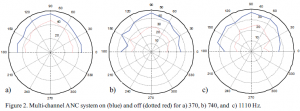Kent L. Gee and Dr. Scott D. Sommerfeldt, Physics and Astronomy
Axial cooling fans used in computers, projectors, and printers often contribute significantly to background noise levels in both the workplace and classroom because of the distinct and often annoying tones they produce. These tones are principally caused by spatially unsteady flow through the fan, due to finger guards and other obstructions. Active noise control (ANC) lends itself as a viable approach to fan tonal noise reduction because of the low frequency nature of the noise, which limits the effectiveness and practicality of more traditional “passive” means of controlling noise. An ANC system cancels or attenuates unwanted noise by creating “antinoise” (noise out of phase with that of the original source), adjusting the control signal until the targeted noise has been minimized.
Limited research performed in the past demonstrated the need for and viability of further research in the area. For example, a study was done in which a single loudspeaker was placed alongside the radiating fan to achieve attenuation of the fan’s tones, and a single error microphone was used to track the minimization of the primary noise. Results demonstrated an ability to attenuate the fundamental tone and subsequent two harmonics significantly at the error microphone, but also showed that global attenuation was much more limited.1 Since global noise reduction is the desired result, especially in an office or a classroom setting, the purpose of the ORCA research carried out was to study the effect of a multi-channel ANC system on the global attenuation of tonal noise from a fan.
In order to simulate a typical configuration, a 3.25 inch “muffin” fan was placed on one of the faces of an aluminum box with roughly the dimensions of a CPU housing, with the air flow outward. Surrounding the fan were four one inch loudspeakers, which were to be the control sources. Because the fan’s tones are harmonics of the blade pass frequency, a convenient tonal reference sensor was an infrared LED and detector placed on opposite sides of the fan blades. The detector produced a periodic square wave as the blades passed which was used by the digital signal processing board-based controller to target and attenuate the fan’s tones. Since cancellation of the fan tones is sensitive to the location of the error microphone(s),2 both the number and location of microphones were varied in order to determine the best configuration. A semicircular measurement boom with thirteen microphones was used to monitor and evaluate the global performance of the ANC system and its effect on the radiated fan tones. To ensure reliable results, all tests were performed in the anechoic chamber in the Eyring Science Center.
The first experiment with the ANC system was a single-chanel test, designed to corroborate the results achieved by Quinlan.1 The error microphone was located equidistant to the edge of the fan and the center of the loudspeaker used, at a distance of 5 cm from the face of the box. The data obtained demonstrates strong correlation to that of Quinlan, with significant attenuation of tones at the error microphone, but less on a global scale. Figure 1 shows the results of the single channel system for the first three fan tones as measured by the boom.
The single-channel ANC results demonstrate limited global attenuation for both 370 and 740 Hz, 6 and 5 dB respectively, but there is very poor coupling between the loudspeaker and fan for 1110 Hz, where there is an overall 2 dB increase in sound pressure level.
Throughout the course of the research, several different speaker/microphone configurations were tried, up to four speakers and microphones, with varying degrees of success. Some configurations resulted in good global attenuation at the fundamental frequency, but like the single-channel system, performed poorly at the higher harmonics. As expected, the overall ability of the ANC system in reducing the fan’s tones was very sensitive to the error microphones’ locations. Past research and convention seemed to indicate that a good microphone location would be between the fan and loudspeaker, as was tried with the single channel system. However, it was discovered that, when using multiple speakers and microphones, a better location for the microphones was a few centimeters beyond the speakers, close to the box. While the reason is not fully understood, this microphone placement greatly increases tonal attenuation at large angles from the fan’s central axis, represented by 90 degrees on the polar plots. Figure 2 demonstrates the effectiveness of the ANC system using all four speakers with an error microphone located just beyond each speaker.
The four speaker/microphone system with the microphones beyond the speakers yields a much greater global cancellation than the single-channel system: 11, 15, and 12 dB for 370, 740, and 1110 Hz respectively. The multiple control sources allow a better coupling between the fan and speakers’ signals, which results in the greater global attenuation.
This research demonstrates multi-channel active control of cooling fan noise, achieving significant tonal attenuations on a global scale. It constitutes an important step in the development of a technology capable of quieting and improving working and learning environments. Multiple loudspeakers and microphones surrounding the cooling fan result in better global attenuation of the significant fan tones than a single-channel system. Also, placement of the error microphone beyond the loudspeaker instead of between the speaker and the fan yields a greater and more consistent tonal reduction at large angles. Future investigations will include varying the locations of the loudspeakers and studying the possibility of using blademounted actuators and sensors.3
References
- D. A. Quinlan, “Application of active control to axial flow fans,” Noise Control Eng. J. 39, 95-101 (1992).
- G. C. Lauchle, J. R. MacGillivray, and D. C. Swanson, “Active control of axial-flow fan noise,” J. Acoust. Soc. Am. 101 (1) 341-349 (1997).
- Special thanks to Julie Slisz of Westminster College, Fulton, MO for her assistance in data acquisition and processing.


